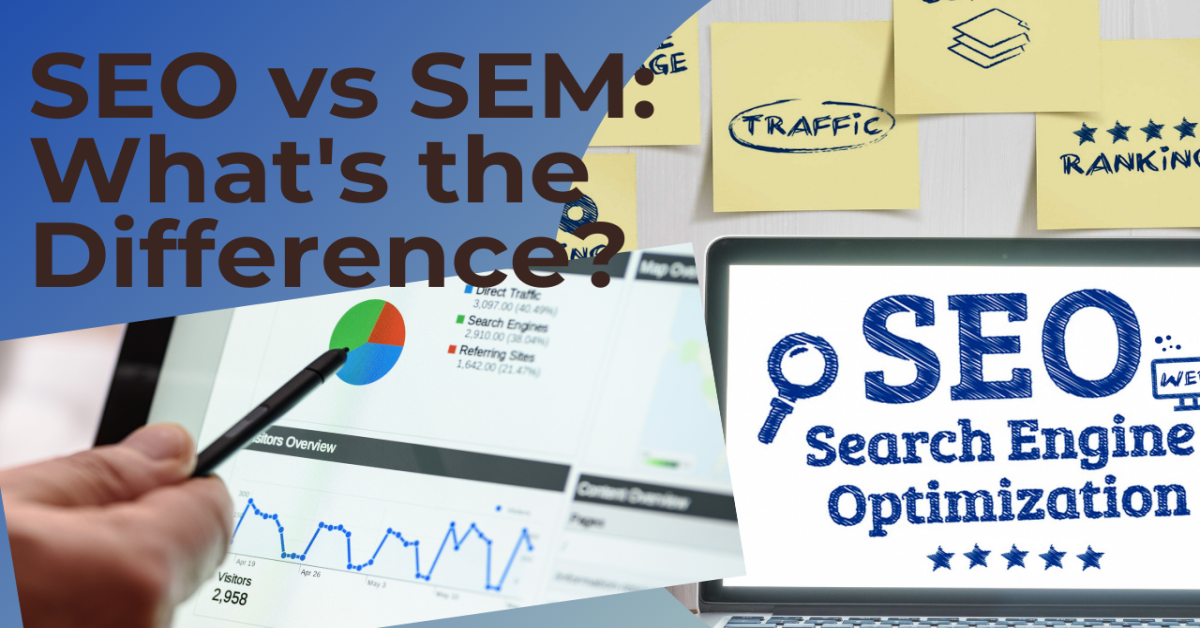If you’re running a business, it’s essential to understand the difference between SEO and SEM. Both strategies are essential for driving traffic to your website, but they work differently. This blog post will discuss the differences between SEO and SEM and help you decide which is right for your business!
First of all,
What is SEO?
Search Engine Optimization (SEO) is an umbrella term for various strategies that help to improve rankings on search engines. It includes technical and creative elements that help websites rank higher in organic results when people search online using specific keywords or phrases relevant to their brand name.

For example, if you own a pizzeria in Boston, you would want to optimize your website for the keyword “Boston pizza.”
SEO is about optimizing your site to appear higher in search engine results pages (SERPs). When someone searches for a term related to your business, you want your website to be the first result they see on Google and other search engines like Bing or Yahoo.
SEO is essential to help people find your website more efficiently and increase traffic from organic searches. As we discussed earlier, this also means better rankings on SERPs, which leads directly to higher conversion rates for sales!
SEO is a long-term strategy that takes time to see results. Be patient and consistent with your efforts to rank higher in search engine results.
Now let’s move on to the SEM,
Search Engine Marketing: SEM is a form of marketing that uses paid advertising to drive website traffic. It can include pay-per-click (PPC) ads, display advertising on social media platforms like Facebook or Twitter, and many other forms of paid promotion.
Unlike SEO which takes time to see results, SEM is an instant way of getting your site in front of your potential customers. It’s also much more expensive than SEO and an incorrect SEM can quickly drain your budget.
If you’re starting a new business or website, it’s essential to understand that SEM takes time and money. You’ll need an advertising budget to see any results from these efforts, which means there’s no guarantee they’ll be successful either!
So, what’s the difference between SEO and SEM?
Differences between SEM and SEO include:
- SEO is a long-term strategy, while one can do SEM in the short term (such as by buying ads).
- The cost of each method greatly depends on how much you want to spend and what tactics you choose to use.
- SEO relies on organic methods like content marketing and link building, while SEM can include paid advertising such as PPC or display ads.
- SEM is an instant way of getting your website in front of potential customers. On the other hand, SEO takes time for results to be seen.
Is SEO a part of SEM?
Yes, SEO is a part of SEM. SEM includes all forms of advertising, including paid search engine results and display ads on social media platforms. However, SEO is only one aspect of SEM – the other half is buying traffic through these various channels.
SEM vs. SEO: The Similarities
Similarities between SEO and SEM include:
- Both are strategies used to drive traffic to a website or business.
- They both require some form of keyword research to find out what people search for when looking for products/services like yours (you can then integrate this into your content marketing strategy).
- Both are digital marketing techniques used by marketers today.
How do SEO and SEM work together?
Now that we’ve explained the difference between SEO and SEM, it’s time to look at how they work together. SEO is the foundation of SEM – without it, your site won’t be able to rank as high in search engine results pages (SERPs). However, SEM can also help to improve your ranking because it increases traffic to your website.
A combined SEO and SEM strategy will give you the best chance of increasing website traffic and improving your business’s bottom line.
What are some of the benefits of using SEO?

- Higher Conversions: As we discussed earlier, this also means higher profits. A study by Google found that websites with higher rankings have more conversions on average than lower-ranked sites. If you want to rank high in the search engine results pages (SERPs), then SEO is an integral part of your marketing strategy because it will help drive traffic and sales for your business or website.
- Higher Customer Satisfaction: A study by Searchmetrics also found that the number one factor for customer satisfaction is the relevance of the search results. It means that when people use a search engine to find information, they are more likely to be satisfied with the results if they are relevant to their query. Optimizing your website and content for SEO can ensure that your customers are satisfied with their experience on your site because you will tailor it according to their needs.
- Higher Traffic: As we discussed earlier, this also means higher profits. A study by Google found that websites with higher rankings have more conversions on average than lower-ranked sites. If you want to rank high in the search engine results pages (SERPs), then SEO is an integral part of your marketing strategy because it will help drive traffic and sales for your business or website.
- Better User Experience: By optimizing your website and content for SEO, you can ensure that users have a better experience on your site. It will lead to more conversions and a higher customer satisfaction rate because it is tailored to their needs.
Some of the benefits of using SEM
- Instant Visibility: When using SEM, your website will immediately be visible to a broader audience. It is because you’re paying to have your site show up in the search engine results pages (SERPs) for specific keywords or phrases.
- Targeted Traffic: With SEM, you can target specific demographics of customers more likely to be interested in your products or services. It is done by targeting specific keywords and phrases relevant to your business.
- Increased ROI: Because SEM is a paid advertising method, you will see a higher return on investment (ROI) than other methods like SEO. It’s because you’re only paying for the traffic that comes to your website, which means you’re not wasting money on traffic that isn’t interested in your products or services.
So, is SEO or SEM more critical?
The answer to this question depends on your specific business and its goals. SEM is the better choice if you’re looking for an instant way of getting your site in front of potential customers. However, SEO is the way to achieve long-term success and better rankings.
Ultimately, it’s essential to understand both methods and use them to get the most out of your digital marketing efforts.
Which one is right for your business?
That depends on your budget and goals! SEO is the best option if you’re looking for a long-term solution to improve your website’s ranking over time. But if you need results quickly and are willing to spend more money, SEM may be suitable for you!
Conclusion
This blog post helps clear any confusion between SEO and SEM, so you can decide which is right for your business! So what are some other differences between these two marketing strategies? Let us know in the comments below.
- Google Ads Customer Service Woes: An Urgent Call for Improvement - January 17, 2024
- Microsoft Copilot Levels Up: Introducing Copilot Pro for $20/Month - January 17, 2024
- Understanding SEO Perfection According to Google’s John Mueller - January 2, 2024

